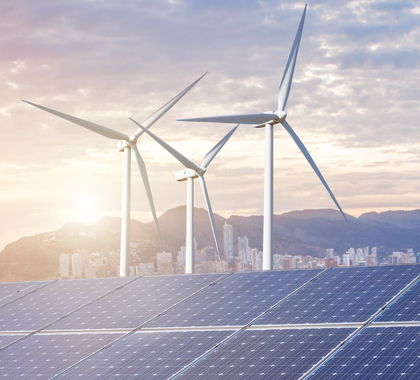A new Policy Brief from The Heartland Institute offers a comprehensive evaluation of seven primary electricity generation sources: biomass, coal, hydropower, natural gas, nuclear, solar, and wind, and assesses each of them based on their affordability, reliability, and environmental impact.
In “Affordable, Reliable and Clean: An Objective Scorecard to Assess Competing Energy Sources,” published in April 2025, each energy source is assigned a numerical score in each of the three categories to facilitate direct comparisons.
The analysis reveals that while renewable sources like wind and solar may appear cost-effective due to federal subsidies, their true costs are higher when accounting for hidden expenses such as backup generation requirements and grid integration challenges.
For example, the report notes, “The utilization of power sources that are intermittent and unpredictable, such as wind and solar power, imposes hidden costs on other energy sources and on the overall electric grid. This is because intermittent energy sources require baseload power facilities like natural gas plants to be cycling and available – racking up costs but selling no power – in the background in case they are needed at a moment’s notice when wind or solar power ramp down. It costs baseload facilities money to be cycling in the background, which adds to the cost of operating natural gas power plants, even though wind and solar power are gaining the sales and imposing those additional operating costs on natural gas power.”
The scorecard ranks natural gas as the least expensive form of electricity generation, followed by coal, hydro, nuclear, biomass, wind, and solar, respectively.
On the reliability metric, the report notes “coal, natural gas, and nuclear are considered baseload power because they can dependably provide reliable, on-demand power whenever they are needed. Biomass can also be available on demand, though biomass fuel stocks are much more limited than abundant coal, natural gas, and uranium. Electrical grid operators can plan well in advance how much power they can generate from these sources in any given hour, day, week, or month. Hydropower is largely on-demand, but drought conditions may affect hydropower generation in certain circumstances.”
However, the report explains, “wind and solar are more problematic from a reliability perspective. Wind turbines generate, on average, only about 35 percent of the power that would be possible under consistently ideal conditions. Solar equipment generates, on average, only about 25 percent of the power that would be possible under sunny skies at high noon. The limited production of wind and solar power is even more problematic because those limited amounts of power production are unpredictable. Wind speeds can vary greatly on a minute-by-minute basis. The same holds true on an hour-by-hour or day-by-day basis. Solar is similar. Even during daylight hours, cloud coverage can vary on a minute-by-minute or hour-by-hour basis. Grid operators must always keep electricity generation and supply in balance, but intermittent and unpredictable wind and solar power impose substantial challenges to doing so and inflict greater costs on other power sources that must be dialed up and down to match wind and solar intermittency.”
The report ranks coal, natural gas, and nuclear as the most reliable forms of electricity generation, followed by biomass and hydro, with wind and solar once again bringing up the rear.
Finally, the report challenges the conventional perception of wind and solar as inherently clean, highlighting concerns including land use, wildlife disruption, and the environmental costs associated with manufacturing and disposing solar panels and wind turbines.
Specifically, the report notes it takes roughly 60 square miles of solar panels or 320 square miles of wind turbines to generate the same amount of power as a baseload power source, and that this large encroachment into wildlife habitats results in the deaths of more than a million birds and bats each year.
What’s more, the report points out that “wind and solar equipment require the mining, refining, and utilization of substantial amounts of toxic metals and rare-earth minerals. Rare-earth mining and the refining of rare-earth minerals are among the most environmentally destructive practices on the planet, typically resulting in widespread and heavily toxic pollution of soil and water.”
Overall, the report ranks nuclear and natural gas as tied for the least environmentally harmful sources of electricity generation, followed by hydro, coal and solar, biomass, and wind.
“Affordable, reliable, and clean are the foundational elements of sound energy policy,” the brief concludes. “[This] in-depth analysis of seven common electrical power sources reveals that natural gas makes the most sense according to the affordable, reliable, and clean standard, with nuclear, hydro, and coal not far behind. Biomass trails by a moderate margin while wind and solar stand apart as the least desirable power sources.”
This scorecard serves as a tool for state policymakers to make informed decisions about energy infrastructure and policy, emphasizing the need for a pragmatic approach that considers the multifaceted implications of energy choices.
State policymakers should encourage a diversified mix of dispatchable, baseload energy sources that prioritize affordability, reliability, and environmental stewardship. Further, they should promote investments in only those energy sources that can reliably meet demand, particularly during peak usage hours or adverse weather conditions and reassess state-level incentives for wind and solar electricity generation to ensure they align with actual performance and do not inadvertently increase costs or reduce grid stability. Lastly, when conducting environmental assessments of energy projects, regulators should consider factors beyond carbon dioxide or greenhouse gas emissions, such as land and water use, and impacts on biodiversity.
Heartland Impact can send an expert to your state to testify or brief your caucus; host an event in your state; or send you further information on a topic. Please don’t hesitate to contact us if we can be of assistance! If you have any questions or comments, contact Cameron Sholty, at csholty@heartlandimpact.org or 312/377-4000.


